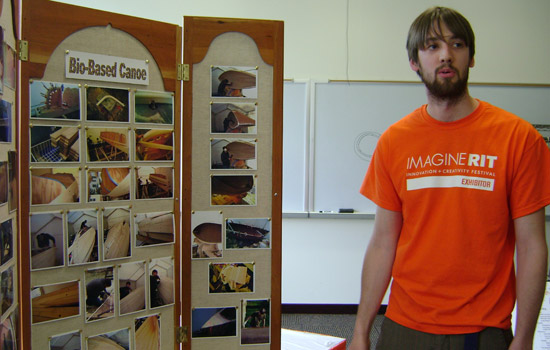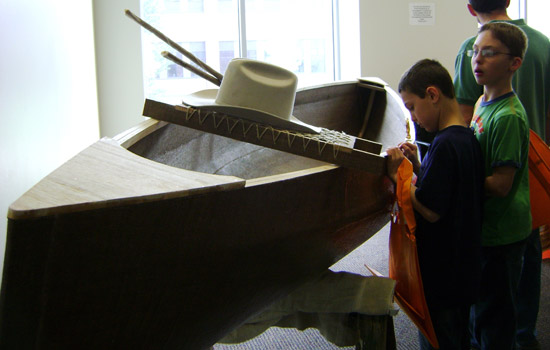Anchors aweigh: Student designs new canoe using green materials
Bio-based materials could provide lower development costs and landfill safety
Michelle Cometa
The canoe was built using balsa wood as a base, then covered with a bio-based epoxy resin for a protective coating. The entire canoe and resin are bio-degradable.
What floats a boat? Mostly wood, steel, fiberglass and even cement.
Christopher Breitfeller has expanded those options to include a bio-based, environmentally friendly material for one of the first “green” canoes. The fifth-year mechanical and manufacturing engineering technology student at RIT will christen the vessel at today’s Imagine RIT: Innovation and Creativity Festival.
He will display his canoe and discuss the bio-based components he used to make it at his exhibit on the first floor of Engineering Technology Hall.
Breitfeller used a bio-based epoxy resin made from vegetable oil to cover the outer layer of the canoe. Research into the use of the bio-epoxy resin has expanded recently and various polymers based on the resin are being formulated as protective barriers for electrical wiring, adhesives and other thin film applications. But Breitfeller says he got the idea for using these bio-based epoxies on his canoe from surfing. The epoxy is used to cover surfboards.
“I found it interesting this didn't get into other similar water-based sports such as kayaking and canoes,” says Breitfeller.
The core of the canoe is made of balsa wood and the outside is coated with a layer of jute cloth, the same cloth used for burlap sacks, he explains. He also looked into using flax as an alternate because like the jute, it is biodegradable.
“The balsa wood was chosen since it is so lightweight and the jute was used due to its low cost,” says Breitfeller. “I made some samples and broke them in impact tests to see how much cloth needed to be applied to the outside to make sure it was strong enough.”
The resin material itself is strong, he adds, but he needed to test the strength of the craft that is a cross between a sculling boat, like the ones used for crew, and a traditional canoe. There will be a seat in the front and back as well as a sliding seat in the middle for sculling.
“Testing the ability to float will happen when I throw her in the water,” he adds, laughing. “However, I know this will not be a problem due to how much water it displaces versus its weight of 50 pounds or so.”
The boat is different in that it will almost completely degrade in a landfill. Breitfeller is in the final stages of the project, putting in the seats and smoothing the outside of the canoe. A final prototype should be completed by early summer.
“I actually have not canoed since middle school, but I love to go fishing and always wanted a small boat,” says Breitfeller. This may be a one-of-a-kind model, and he may have floated into a brand new business.
 Christopher Breitfeller talked about the process of building the bio-canoe at the Imagine Festival. Michelle Cometa
Christopher Breitfeller talked about the process of building the bio-canoe at the Imagine Festival. Michelle Cometa


